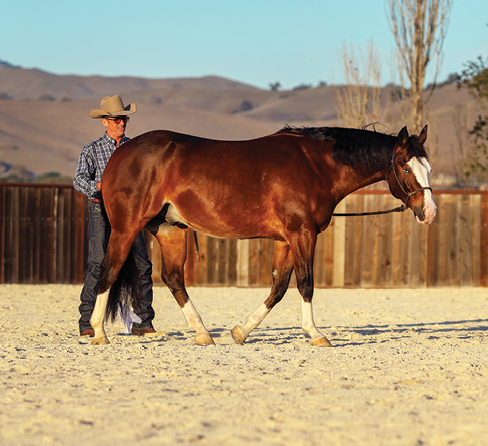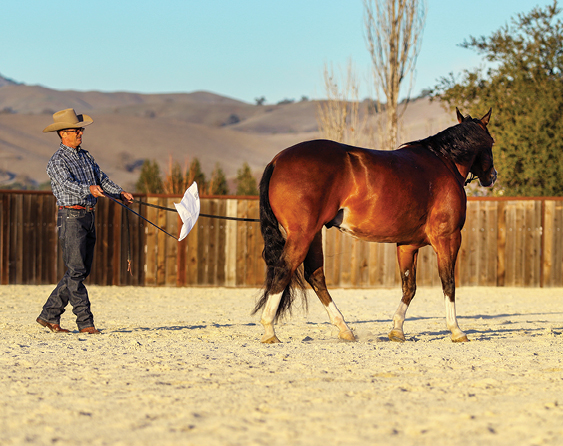You halter your horse, snap on the lead rope, and head out of the barn. As you lead him, he becomes pushy and tries to drag you around the barn. The more often this scenario happens, the more you’re going to struggle with gaining control on the ground. If your horse likes to pull you all over the place—or even worse, tries to climb on top of you—there’s a chance he’s reading your energy and senses a lack of security in you.
[MORE WITH WARWICK: HALF-HALT YOUR WESTERN HORSE]
Here I’ll go over why your horse is becoming anxious in the first place. Then I’ll show you three simple steps that’ll help you regain communication with your horse, allow you to connect his thoughts to the end of your lead rope, and give him a sense of security when you’re next to him.
How You Make Him Anxious
Most of the time, this behavior starts with the way you’re leading your horse. When you hold a lead rope, you should be relaxed and not have constant pressure on your horse’s head. If your arm is stiff or you’re constantly pulling on him, he’s going to become stiff or try to escape the pressure you have on his halter.
Your horse communicates with his energy, whether it’s with you or when he’s in the pasture with other horses. If he senses danger, he’s going to relay the message to the rest of the herd with his body language. This means he’s also going to read your body language, or the other horses in the pasture’s body language, to figure out if he needs to seek safety. So if you’re rigged or stiff in your body giving off nervous energy, you’re telling your horse, without even realizing it, that he should be tense and nervous, as well. Then when your body becomes defensive to your horse’s reactions, you become even more rigid and lean away from the danger, making your ask on the lead rope ineffective.
To be successful with this exercise, you need to be able to control your emotions when you’re around your horse. Once you can do that, your horse will begin to follow your lead, and learn how to relax and walk calmly on the lead rope.

1. Be Aware of Yourself
Head to a small arena or a round pen with your horse and start this exercise by focusing on how you and your horse respond to things in your environment. If a scary situation arises with your horse, like a plastic bag floating by, and you or your horse react, work on your thoughts, energy, and physical actions required to handle the situation while remaining calm.
Focus on what you want to happen during that moment by creating a mental picture and bringing your attention to the present. Acknowledge the issue at hand, look at what your horse is looking at, talk out loud saying that you see the problem and that it’s nothing to worry about, keep your arm in a relaxed position, and maintain your confidence throughout the spooky scenario. Take time to observe what’s happening without attaching it to a catastrophic future event.
If you’re unable to practice this part of the exercise with your horse in hand because of how reactive he is, start by practicing without him. Pretend that the plastic bag, or whatever might be spooky to your horse, is floating by. Then focus on your thoughts and energy required to handle the scenario.
[MORE WITH WARWICK: IMPROVE YOUR HORSE’S TRAIL BEHAVIOR]

2. Release Lead-Rope Pressure
With a flag in one hand and the end of your lead rope in the other, give your horse enough slack to stand relaxed, but don’t let go of the lead rope completely. The slack in your lead is how you open the window to communicate with your horse.
If your horse starts to move around, let him move a few steps—he should have the option to look or step away from what’s worrying him. (At this time in the exercise, you want to avoid any pressure on the lead rope.)
As your horse starts to wander away from you, it’s easy return to your old habit and tighten up on your lead rope or pull on his head to stop him. Instead, focus on your reaction and stay aware of what your body is doing at all times.

3. Attract His Attention
Next, you’ll want to initiate communication with your horse by applying some pressure to the lead rope and taking the slack out as your horse moves. Wave your flag near his hindquarters, but don’t step toward him. You want to attract his attention but not walk into his body and naturally push him away from you.
As you wave the flag and bring his attention back on you, gently gather the slack in your lead rope and create slight pressure as he brings his head back around. Once his head is facing you and you have his attention, give him slack in the lead and start the process over, repeating until your horse is able to walk quietly next to you while you lead him.
Remember, this exercise is about you and your horse. Whenever you begin to feel worried and create anxious energy, go back to step one and gradually move on to the next steps as your confidence increases and you become more comfortable controlling your horse from the ground.






